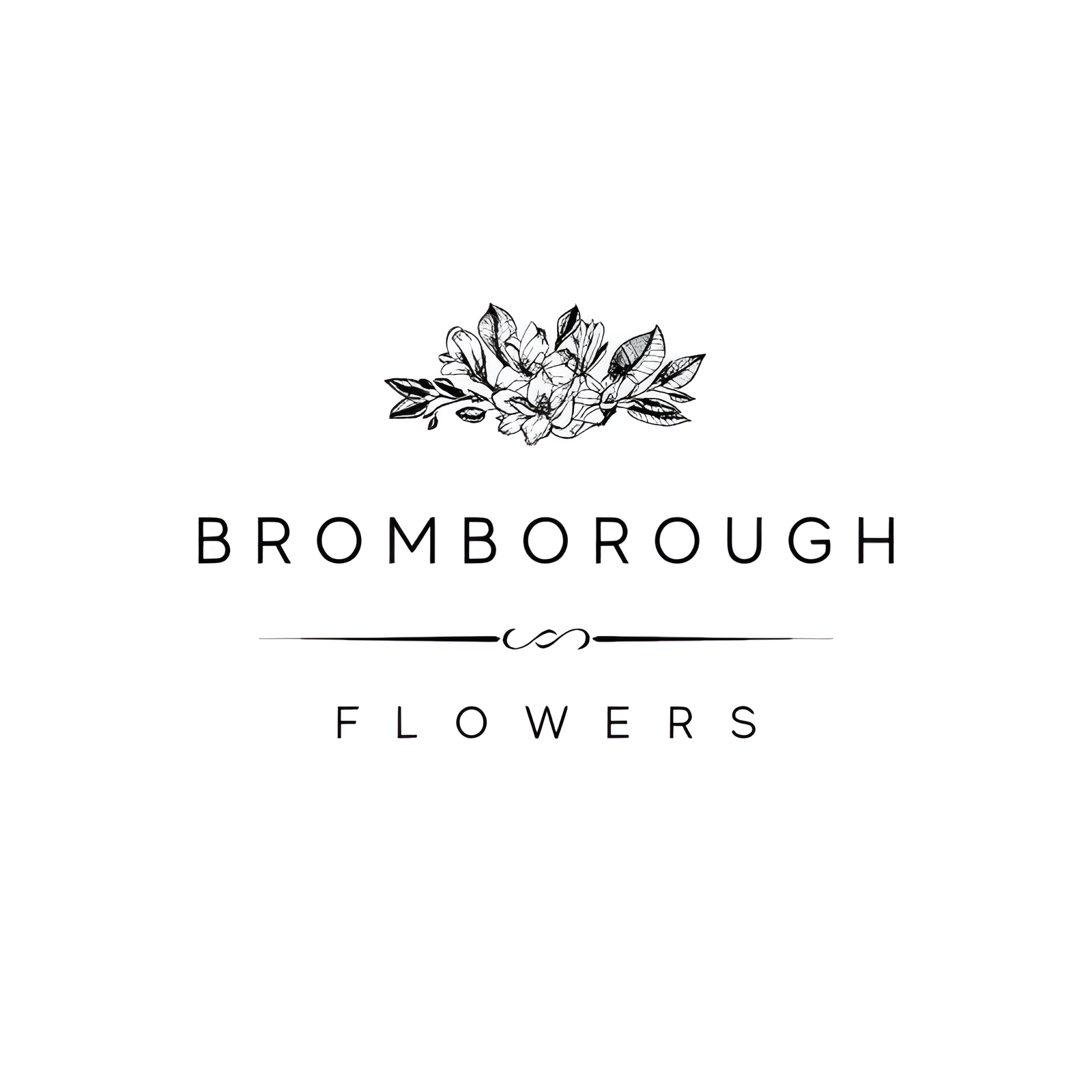The daffodil, with its vibrant hues and symbolic resonance, stands as a compelling choice for wedding floral arrangements. Known for its star-and-cup shape and central trumpet-shaped corona, this perennial flower brings an aesthetic appeal and a deeper meaning of rebirth and joy. Available in over 50 color varieties, from classic yellow to unique pinks and reds, daffodils infuse a fresh, springtime allure into any celebration. Yet, their charm extends beyond mere appearance; their cultural significance and versatility in arrangements make them indispensable. To uncover how daffodils can transform your wedding, one must consider…
Flower Overview
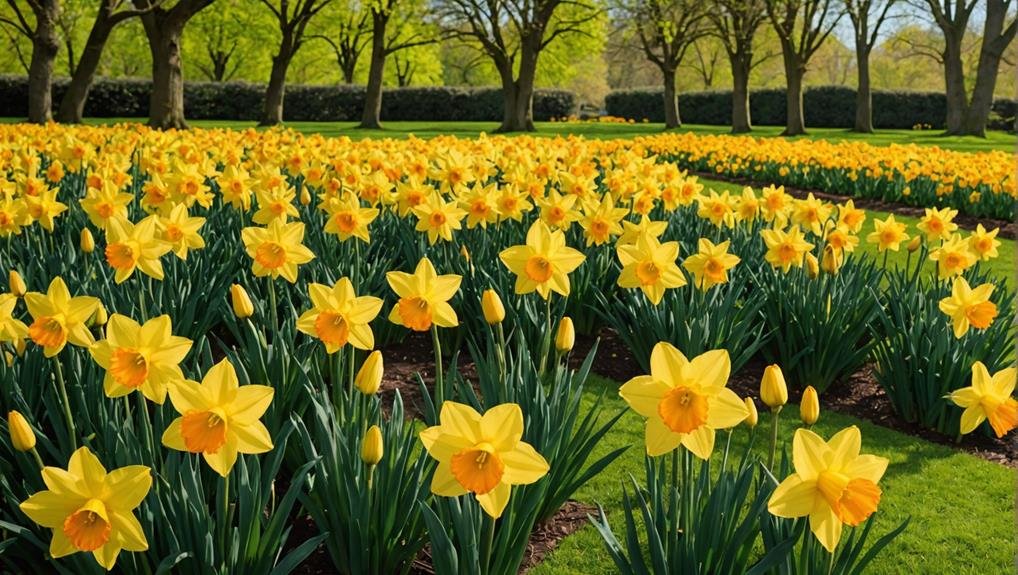
Daffodils, emblematic of rebirth, good fortune, joy, and hope, are a versatile and symbolic choice for wedding floral arrangements. These spring blooms bring a sense of freshness and renewal to any wedding setting, making them particularly fitting for ceremonies held during the spring season.
With over 50 varieties available, daffodils offer a spectrum of colors including white, yellow, orange, pink, and red, providing ample options to complement various wedding themes and color palettes.
Incorporating daffodils into wedding decor can elevate the aesthetic appeal of the event. These flowers can be elegantly paired with other popular wedding blooms such as ranunculus, roses, lilies, tulips, and hyacinths, creating intricate and visually enchanting floral displays.
Brides looking to add a touch of natural beauty to their attire might consider a daffodil-adorned bridal crown, which can offer a whimsical and ethereal look.
Common color schemes for daffodil arrangements often include combinations of white and green or yellow, white, and green, which can seamlessly blend with both modern and traditional wedding styles. Overall, daffodils are a timeless choice that brings warmth and positivity to any wedding celebration.
Physical Description
Renowned for their vibrant colors and iconic star-and-cup shape, these springtime blooms display both single and double varieties, adding a unique charm to wedding floral arrangements. Daffodils, also known as bulb flowers, emerge from underground bulbs, making them perennial favorites in many gardens and floral designs. Their distinct physical appearance includes a central trumpet-shaped corona surrounded by a ring of petal-like tepals, creating a striking contrast that captivates attention and enhances their allure.
The single varieties of daffodils typically have one flower per stem, showcasing a simple yet graceful form, while the double varieties feature multiple layers of petals, contributing to a fuller and more intricate look. These traits make daffodils versatile additions to both simplistic and elaborate wedding bouquets.
Due to their delicate nature, extra stems may be needed to ensure that the daffodils maintain their shape and integrity throughout the event. The stems are slim yet robust enough to support the blooms, making them suitable for various floral arrangements.
Available Colour Varieties
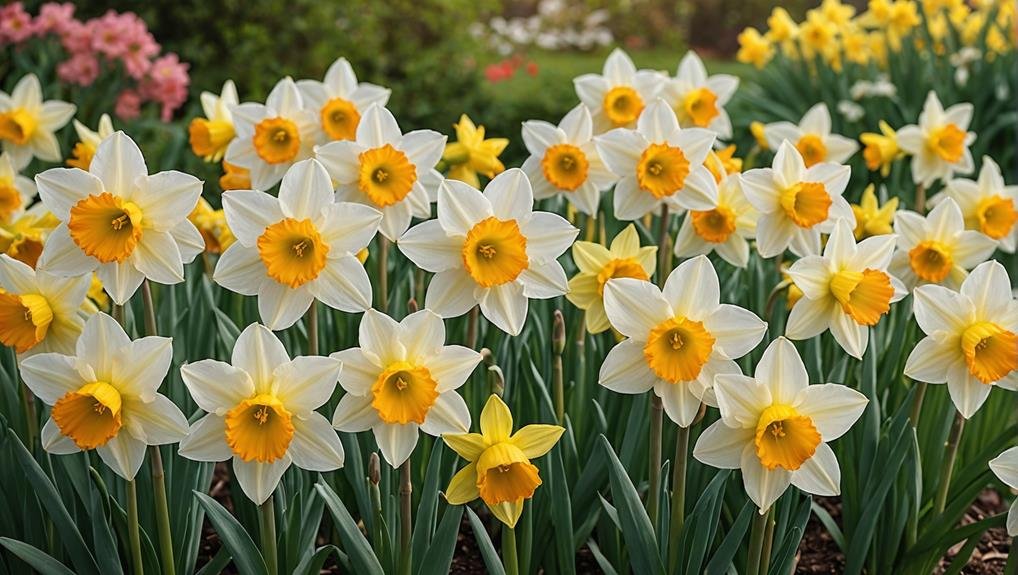
Among the many attributes that make daffodils a favored choice for wedding flowers is their impressive range of available color varieties. Daffodils are celebrated for their versatility and aesthetic appeal, making them suitable for diverse wedding themes and color palettes. These charming bulb flowers come in a stunning array of hues, including white, yellow, orange, pink, and red. This variety allows for endless creative combinations, guaranteeing that daffodils can complement any wedding decor.
Yellow daffodils are perhaps the most iconic, symbolizing cheerfulness and new beginnings. They can create a vibrant, sunny atmosphere when paired with other bright colors like coral, pink, or purple. For those seeking a more subtle elegance, daffodils in classic palettes of white and green offer a timeless beauty that never goes out of style. Additionally, the sunset color palettes achieved by mixing different varieties of daffodils can add warmth and depth to any floral arrangement.
- Classic Elegance: White and green daffodils for a timeless look.
- Vibrant Combinations: Yellow daffodils paired with coral, pink, or purple.
- Sunset Hues: Mixing different varieties for a warm, inviting palette.
The wide range of color options guarantees that daffodils can be tailored to any wedding vision.
Latin Name and Taxonomy
The botanical name for the daffodil is Narcissus, a genus that belongs to the Amaryllidaceae family. This Latin name is universally recognized in scientific communities and helps ensure consistency across various regions and languages. Taxonomically, daffodils are classified within the Asparagales order. This classification places them among other monocotyledonous flowering plants, known for their significant horticultural and ecological importance.
Within the genus Narcissus, there are various species and numerous hybrids, encompassing over 50 different varieties. These bulbous plants are renowned for their trumpet-shaped corona, which is elegantly surrounded by six petal-like tepals. Such distinct morphology makes daffodils a popular choice for spring weddings.
Narcissus pseudonarcissus is one of the most commonly cultivated species in gardens. Its striking appearance, characterized by a prominent central trumpet and vibrant colors, embodies the quintessential image of a daffodil. The taxonomy of Narcissus is crucial for gardeners and florists alike, enabling them to identify and cultivate specific varieties that best suit their aesthetic and environmental needs.
Understanding the taxonomy and Latin name of daffodils provides valuable insight into their classification and characteristics, enriching our appreciation of these beloved springtime blooms.
Geographical Origins
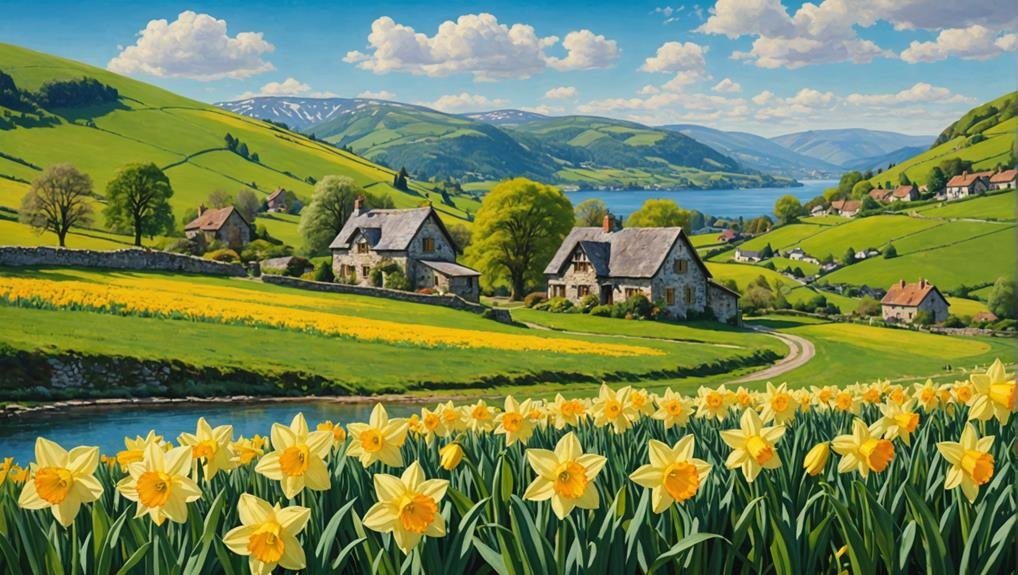
Daffodils, known scientifically as Narcissus, trace their origins to the Mediterranean region, particularly Spain and Portugal. These regions provided the ideal environment for these bulbous flowers to thrive, thanks to their temperate climate and well-drained soil. Over centuries, the cultivation of daffodils has expanded far beyond their Mediterranean roots, making them a widely recognized and cherished flower worldwide.
With their strong ties to the Mediterranean, daffodils have been extensively cultivated in various parts of the world, including:
- The United Kingdom
- The Netherlands
- The United States
The geographical origins of daffodils are not only limited to their initial Mediterranean habitat. Through continuous cultivation and hybridization, different varieties have emerged, each adapting to various climates.
The Netherlands, for instance, is renowned for its extensive bulb fields, producing millions of daffodils annually for both domestic use and export.
In the United States, daffodils are commonly grown in regions with similar temperate climates, ensuring their proliferation and availability.
Season Availability
Typically in season during March and April, daffodils are an ideal choice for spring weddings. Their presence during these months guarantees fresh, vibrant blooms that can enhance the aesthetic of any bridal party. Daffodils’ appearance in spring aligns perfectly with the season’s themes of renewal and new beginnings, which resonate deeply with the wedding ceremony’s essence.
With over 50 varieties, daffodils offer an extensive palette of colors, allowing couples to select shades that complement their wedding theme. This versatility makes daffodils a popular option not only for bouquets but also for centerpieces and other decorative elements.
The joyful and positive connotations of daffodils add to their appeal, helping to infuse the occasion with a sense of happiness and optimism.
Moreover, the seasonal presence of daffodils means that they can be sourced locally, often at a lower cost than out-of-season flowers. This can be a significant advantage for budget-conscious couples looking to maximize the beauty of their floral arrangements without incurring high expenses.
Growing Conditions
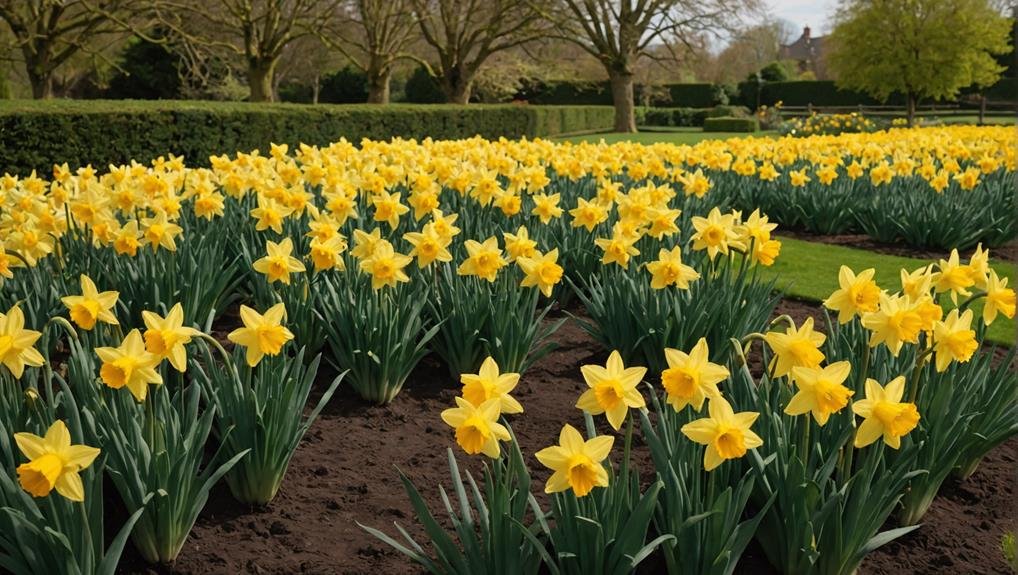
To fully appreciate the beauty of daffodils in your wedding arrangements, understanding their ideal growing conditions is essential. Daffodils thrive in environments that offer full sunlight to gentle shade.
The best planting time for these vibrant flowers is from September to December, guaranteeing they have sufficient time to establish roots before the blooming season.
When planting daffodils, it is important to take into account the depth and spacing of the bulbs. Large daffodil bulbs should be planted 6-8 inches deep and spaced 4-6 inches apart to promote healthy growth and ideal blooming. These conditions allow the bulbs to develop strong root systems and access necessary nutrients from the soil.
Daffodils are known for being low-maintenance, making them an excellent choice for both novice and experienced gardeners. However, it is important to handle them carefully due to their toxic sap, which can be harmful if ingested or if it comes into contact with sensitive skin.
Here are a few key points to remember:
- Full sunlight to gentle shade: Ideal light conditions for growth.
- September to December: Best planting time for daffodils.
- 6-8 inches deep, 4-6 inches apart: Ideal planting depth and spacing.
Understanding these growing conditions will guarantee that your daffodils flourish, adding a touch of elegance and charm to your wedding flowers.
Cultural Significance
Renowned for their symbolism, daffodils convey themes of rebirth, good fortune, joy, and hope across various cultures. As quintessential spring flowers, their vibrant presence heralds the arrival of warmer days and new beginnings. This symbolism is deeply rooted in their natural lifecycle, emerging from the ground each spring, which makes them a powerful metaphor for renewal and optimism.
In many Western cultures, daffodils are considered harbingers of good luck and prosperity. Their bright yellow petals are synonymous with happiness and positivity, contributing to their cultural significance in celebratory contexts. This association with joy and fortune extends beyond their visual appeal, embedding them in various traditions and folklore. For instance, in Wales, daffodils are worn on St. David’s Day as a national symbol of pride and heritage.
The versatility of daffodils is further emphasized by the over 50 varieties available, each bringing unique hues and forms to floral arrangements. This diversity allows for personalized expressions of cultural significance, making daffodils a fitting choice for a range of ceremonies and celebrations. Their in-season availability during March and April also aligns them perfectly with springtime events, enhancing their role as symbols of renewal.
Typical Use in Weddings
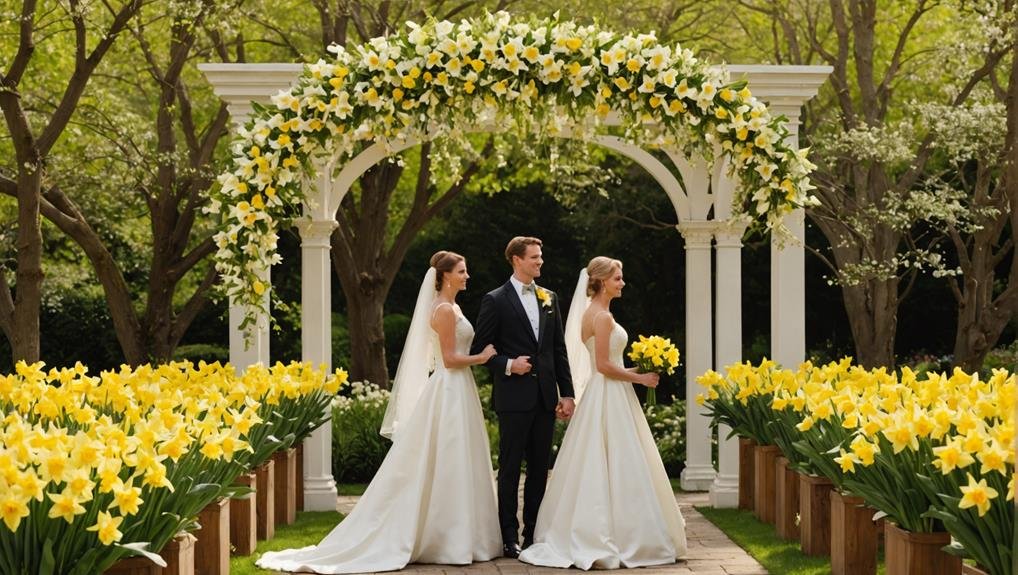
In wedding ceremonies, daffodils are often used in various floral arrangements such as bridal bouquets, boutonnieres, and centerpieces. Their vibrant colors and symbolic meanings of rebirth, good fortune, joy, and hope make them a fitting choice for spring weddings. With over 50 varieties, daffodils offer a wide spectrum of colors ranging from white and yellow to orange, pink, and red, allowing for diverse and enchanting floral displays.
Daffodils can be seamlessly incorporated into a multitude of wedding floral arrangements. They complement other flowers like ranunculus, roses, lilies, tulips, and hyacinths, creating stunning and harmonious compositions. The versatility of daffodils allows them to be used in:
- Bridal Bouquets: Adding a touch of brightness and symbolism, daffodils make bridal bouquets both aesthetically pleasing and meaningful.
- Boutonnieres: Groomsmen and other key figures can wear daffodil boutonnieres, tying in the floral theme throughout the wedding party.
- Centerpieces: Arrangements featuring daffodils can enhance reception tables, bringing an element of natural beauty and charm.
Moreover, daffodils are cost-effective when in season, providing a budget-friendly option without compromising on elegance or visual impact. Their unique qualities and vibrant hues ensure that they can elevate any wedding’s floral decor.
Alternative Flower Types
Exploring alternative flower types like tulips, hyacinths, and ranunculus can add diversity and fragrance to your wedding floral arrangements.
Tulips are a versatile choice, available in a wide range of colors that can match any wedding theme. Their heliotropic nature, where they follow the sun, adds a dynamic element to the arrangements, making them visually engaging.
Hyacinths offer another fragrant option, enhancing the sensory experience of your wedding. Their dense clusters of small flowers come in various hues, from soft pastels to vibrant shades, providing ample opportunities for creative floral designs. The sweet scent of hyacinths can also contribute to a memorable ambiance.
Ranunculus, with their delicate and layered petals, can beautifully complement daffodils and other blooms in your wedding arrangements. Available in an array of colors, they can be used to add texture and depth to bouquets and centerpieces, making your floral displays more intricate and appealing.
